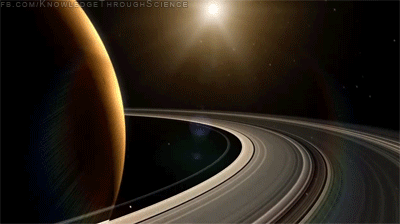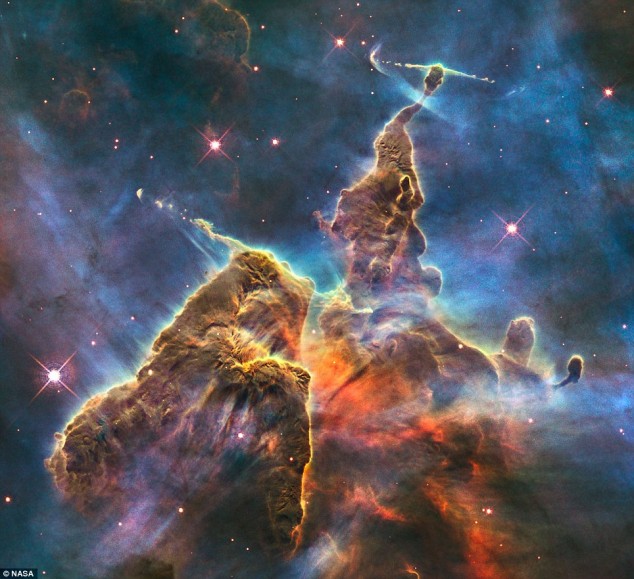FROM THE APOD Explanation: Our solar system's miasma of incandescent plasma, the Sun may look a little scary here. The picture is a composite of 25 images recorded in extreme ultraviolet light by the orbiting Solar Dynamics Observatory between April 16, 2012 and April 15, 2013. The particular wavelength of light, 171 angstroms, shows emission from highly ionized iron atoms in the solar corona at a characteristic temperatures of about 600,000 kelvins (about 1 million degrees F). Girdling both sides of the equator during approach to maximum in the 11-year solar cycle, the solar active regions are laced with bright loops and arcs along magnetic field lines. Of course, a more familiar visible light view would show the bright active regions as groups of dark sunspots. Three years of Solar Dynamics Observatory images are compressed in the video:
Celestial Size Chart
This is a crisp and clear star size chart to help me understand my place in the universe.
Photo of the Day - Animated GIF Flyby of Saturn's Rings
The rings of Saturn are only about 30 feet (10 meters) thick in most parts of the main rings, other parts however are often up to several kilometers thick. The rings are made of dusty ice, in the form of boulder-sized and smaller chunks that gently collide with each other as they orbit around Saturn. Saturn’s gravitational field constantly disrupts these ice chunks, keeping them spread out and preventing them from combining to form a moon.
Beautiful and Fascinating HD Images of the Sun by Alan Friedman
"My photographs comprise a solar diary, portraits of a moment in the life of our local star. Most are captured from my backyard in Buffalo, NY. Using a small telescope and narrow band filters I can capture details in high resolution and record movements in the solar atmosphere that change over hours and sometimes minutes. The raw material for my work is black and white and often blurry. As I prepare the pictures, color is applied and tonality is adjusted to better render the features. It is photojournalism of a sort. The portraits are real, not painted. Aesthetic decisions are made with respect for accuracy as well as for the power of the image."
100,000 Stars - Great Chrome Experiment
From the Project:
"100,000 Stars is an interactive visualization of the stellar neighborhood created for the Google Chrome web browser. It shows the location of 119,617 nearby stars derived from multiple sources, including the 1989 Hipparcos mission. Zooming in reveals 87 individually identified stars and our solar system. The galaxy view is an artist's rendition based on NGC 1232, a spiral galaxy like the Milky Way."
Leaving Earth: Timelapse of Moving Away from Earth
From NASA:
Explanation: What it would look like to leave planet Earth? Such an event was recorded visually in great detail by the MESSENGER spacecraft as it swung back past the Earth, eight years ago, on its way in toward the planet Mercury. Earth can be seen rotating in this time-lapse video, as it recedes into the distance. The sunlit half of Earth is so bright that background stars are not visible. The robotic MESSENGER spacecraft is now in orbit around Mercury and has recently concluded the first complete map of the surface. On occasion, MESSENGER has continued to peer back at its home world. MESSENGER is one of the few things created on the Earth that has left and will never return -- at the end of its mission MESSENGER will be crashed into Mercury's surface.
Why We Point Our Most Expensive Cameras Out: The Beauty of Space Photography
Astrophysicist Dr. Emily Rice, Hubble Image Processor Zolt Levay and Astronomer David W. Hogg were brought together in this video by PBS to talk on why it's so beautiful and how it's so important to take photos of space.
Animated Visualization of Earth's Meteor Strikes
Carlo Zapponi created this astounding (and fun) animated visualization of all meteorites that have ever been reported to hit the earth: about 1,042 meteorites in total.
Click through to see the whole experience.
5 - Our Planets
Lovely animation by Pablo Maximiliano of our planets.
More Animation
5 Most Beautiful Posts of 2012
Not in any particular order, the 5 most beautiful posts we've made this year.
1. Van Gogh's Starry Sky Remade with Images from Hubble Telescope
Harvard PhD student Alex Parker use the top 100 images from the Hubble telescope and a mosaic-making program to make this stunning version of Van Gogh’s masterpiece.
2. The Form of the Body
On Body Forms: Photos by Klaus Kampert
Director and cinematographer Ron Ficke (Koyaanisqatsi, Baraka) has been hard at work on Samsara for 5 years. The entire film is shot in stunning 70mm. It is a film that relies completely on its visual impact and cinematographic juxtaposition, as there isn't any dialogue.
Beautifully shot short film on the letterpress.
5. Timelapse of Meteor Shower Over Joshua Tree
via The Atlantic Master Feed:
"In Ascendance, nature photographer Henry Jun Wah Lee documents the Perseid meteor shower at its peak in August, before a backdrop of Joshua Tree National Park and the Ancient Bristlecone Pine Forest. It's worth watching the video full screen to appreciate the crisp cinematography and magical details -- rainbows, stars, and more. "
APP of the Day - Solar Walk 3D Solar System Model
Between the smooth, slick and responsive UI and the stunning visualizations and astounding information, there isn't much about SOLAR WALK I don't like. I actually feel like it is a steal at $2.99. And as amazing it is on the iPhone, on the iPad it is truly astounding.
5 - The Earth - Overview Effect
The original Blue Marble photo (to the right) is 40 years old now. I find it and this video extremely moving and oddly comforting.
More Astronomy
Get 5 things in your Inbox
1 - Carl Sagan's Pale Blue Dot in Animation
"From this distant vantage point, the Earth might not seem of any particular interest. But for us, it’s different. Consider again that dot. That’s here. That’s home. That’s us. On it everyone you love, everyone you know, everyone you ever heard of, every human being who ever was, lived out their lives."
A remarkable animation by studio ORDER.
3 - Timelapse of the Australian Solar Eclipse
Australia had a solar eclipse last month. Photographer Colin Legg made this outstanding timelapse of it.
More Astronomy
2 - 100,000 Stars - The Milky Way Gets the Google Maps Treatment
While this only works on Chrome, this stunning star viewer, complete with guided tour about blew my mind this morning. So much fun.
3 - The Known Universe
From the American Museum of Natural History:
"The Known Universe takes viewers from the Himalayas through our atmosphere and the inky black of space to the afterglow of the Big Bang. Every star, planet, and quasar seen in the film is possible because of the world's most complete four-dimensional map of the universe, the Digital Universe Atlas that is maintained and updated by astrophysicists at the American Museum of Natural History. The new film, created by the Museum, is part of an exhibition, Visions of the Cosmos: From the Milky Ocean to an Evolving Universe, at the Rubin Museum of Art in Manhattan through May 2010. "
More Space
More Visualizations
Poem of the Day
5 - Van Gogh's Starry Night Recreated With Hubble Telescope Images
Harvard PhD student Alex Parker use the top 100 images from the Hubble telescope and a mosaic-making program to make this stunning version of Van Gogh’s masterpiece.
2 - Incredible Visualization of Asteroid Discovery
This motion visualization of the discovery of asteroids from 1980 to 2012. Watch it full screen at original resolution if you can.
































































































